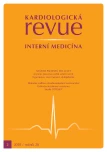Oxygen therapy for suspected acute myocardial infarction – DETO2X-AMI
Authors:
O. Ludka
Authors‘ workplace:
Interní kardiologická klinika LF MU a FN Brno Mezinárodní centrum klinického výzkumu, FN u sv. Anny v Brně
Published in:
Kardiol Rev Int Med 2018, 20(2): 137-141
Overview
Background:
The clinical effect of routine oxygen therapy in patients with suspected acute myocardial infarction without hypoxemia at baseline is uncertain.
Methods: In this registry-based randomized clinical trial, we used nationwide Swedish registries for patient enrolment and data collection. Patients with suspected myocardial infarction and an oxygen saturation of 90% or higher were randomly assigned to receive either supplemental oxygen (6 litre per minute for 6 to 12 hours, delivered through an open face mask) or ambient air.
Results:
A total of 6,629 patients were enrolled. The median duration of oxygen therapy was 11.6 hours, and the median oxygen saturation at the end of the treatment period was 99% among patients assigned to oxygen and 97% among patients assigned to ambient air. Hypoxemia developed in 62 patients (1.9%) in the oxygen group, as compared with 254 patients (7.7%) in the ambient-air group. The median of the highest troponin level during hospitalization was 946.5 ng per litre in the oxygen group and 983.0 ng per litre in the ambient-air group. The primary end point of death from any cause within 1 year after randomization occurred in 5.0% of patients (166 of 3,311) assigned to oxygen and in 5.1% of patients (168 of 3,318) assigned to ambient air (HR 0.97; 95% CI 0.79–1.21; P = 0.80). Re-hospitalization with myocardial infarction within 1 year occurred in 126 patients (3.8%) assigned to oxygen and in 111 patients (3.3%) assigned to ambient air (HR 1.13; 95% CI 0.88–1.46; P = 0.33). The results were consistent across all predefined subgroups.
Conclusions:
Routine use of supplemental oxygen in patients with suspected myocardial infarction without hypoxemia was not found to reduce 1-year all-cause mortality.
Key words
myocardial infarction – oxygen
Sources
1. Steele C. Severe angina pectoris relieved by oxygen inhalations. BMJ 1900; 2: 1568.
2. Steg PG, James SK, Atar D et al. ESC Guidelines for the management of acute myocardial infarction in patients presenting with ST-segment elevation. Eur Heart J 2012; 33(20): 2569– 2619. doi: 10.1093/ eurheartj/ ehs215.
3. Roffi M, Patrono C, Collet JP et al. 2015 ESC Guidelines for the management of acute coronary syndromes in patients presenting without persistent ST-segment elevation: task force for the management of acute coronary syndromes in patients presenting without persistent ST-segment elevation of the European Society of Cardiology (ESC). Eur Heart J 2016; 37(3): 267– 315. doi: 10.1093/ eurheartj/ ehv320.
4. Maroko PR, Radvany P, Braunwald E et al. Reduction of infarct size by oxygen inhalation following acute coronary occlusion. Circulation 1975; 52(3): 360– 368.
5. Madias JE, Madias NE, Hood WB Jr. Precordial ST-segment mapping. 2. Effects of oxygen inhalation on ischemic injury in patients with acute myocardial infarction. Circulation 1976; 53(3): 411– 417.
6. Kelly RF, Hursey TL, Parrillo JE et al. Effect of 100% oxygen administration on infarct size and left ventricular function in a canine model of myocardial infarction and reperfusion. Am Heart J 1995; 130(5): 957– 965.
7. Moradkhan R, Sinoway LI. Revisiting the role of oxygen therapy in cardiac patients. J Am Coll Cardiol 2010; 56(13): 1013– 1016. doi: 10.1016/ j.jacc.2010.04.052.
8. Zweier JL, Talukder MAH. The role of oxidants and free radicals in reperfusion injury. Cardiovasc Res 2006; 70(2): 181– 190. doi: 10.1016/ j.cardiores.2006.02.025.
9. Stub D, Smith K, Bernard S et al. Air versus oxygen in ST-segment-elevation myocardial infarction. Circulation 2015; 131(24): 2143– 2150. doi: 10.1161/ CIRCULATIONAHA.114.014494.
10. Cabello JB, Burls A, Emparanza JI et al. Oxygen therapy for acute myocardial infarction. Cochrane Database Syst Rev 2016; 12: CD007160. doi: 10.1002/ 14651858.CD007160.pub4.
11. Steyerberg EW, Bossuyt PM, Lee KL. Clinical trials in acute myocardial infarction: should we adjust for baseline characteristics? Am Heart J 2000; 139(5): 745– 751.
12. Sepehrvand N, Ezekowitz JA. Oxygen therapy in patients with acute heart failure: friend or foe? JACC Heart Fail 2016; 4(10): 783– 790. doi: 10.1016/ j.jchf.2016.03.026.
13. Khoshnood A, Carlsson M, Akbarzadeh M et al. Effect of oxygen therapy on myocardial salvage in ST elevation myocardial infarction: the randomized SOCCER trial. Eur J Emerg Med 2018; 25(2): 78– 84. doi: 10.1097/ MEJ.0000000000000431.
14. Schömig A, Kastrati A, Dirschinger J et al. Coronary stenting plus platelet glycoprotein IIb/ IIIa blockade compared with tissue plasminogen activator in acute myocardial infarction. N Engl J Med 2000; 343(6): 385– 391. doi: 10.1056/ NEJM200008103430602.
15. Hofmann R, James SK, Jernberg T et al. Oxygen therapy in suspected acute myocardial infarction. N Engl J Med 2017; 377(13): 1240– 1249. doi: 10.1056/ NEJMoa1706222.
Labels
Paediatric cardiology Internal medicine Cardiac surgery CardiologyArticle was published in
Cardiology Review

2018 Issue 2
Most read in this issue
- Arrhythmias in young adults
- Juvenile hypertension
- Fixed dose combination of rosuvastatin and ezetimibe – drug profile
- Chronic venous insufficiency and varicose veins in young people
